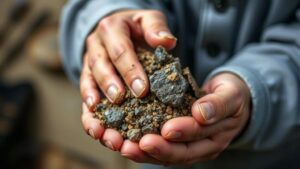The Science Behind Alluvial Gold Deposits: What Makes Them Rich?
The Science Behind Alluvial Gold Deposits: What Makes Them Rich?
Alluvial gold deposits have fascinated prospectors and geologists alike due to their rich deposits of gold easily accessible through sedimentary processes. Understanding the science behind these formations not only helps in identifying potential sites for mining but also provides insights into geological processes. This article explores the formation, characteristics, and the economic importance of alluvial gold deposits.
Formation of Alluvial Gold Deposits
Alluvial gold deposits are formed through the natural weathering of rocks that contain gold. This process involves several stages:
- Weathering: The parent rocks, often quartz veins, undergo erosion and physical weathering due to wind and water.
- Transport: As water moves through soil and streams, it transports gold particles. Golds high density allows it to settle in specific locations, forming deposits.
- Deposition: Gold particles settle out of the water in areas of lower energy flow, such as river bends or behind boulders in streams, accumulating as alluvial deposits.
For example, in the Klondike region of Canada during the Gold Rush, miners found substantial alluvial gold deposits in riverbeds, leading to a significant influx of settlers in the 1890s.
Characteristics of Alluvial Gold Deposits
Alluvial gold is typically characterized by its fineness and distinct morphology:
- Particle Size: Alluvial gold can vary in size from fine dust to nuggets weighing several grams, depending on the geological conditions.
- Shape: Over time, gold particles become rounded as they are subjected to erosion, allowing them to be easily separated during mining.
- Purity: Alluvial gold often has high purity levels, reaching up to 90-98%, making it valuable for various applications.
Economic Importance of Alluvial Gold
Alluvial gold mining plays a significant role in local and national economies, especially in developing countries. It provides jobs, stimulates local economies, and generates export revenue:
- Job Creation: Many communities depend on alluvial mining for employment. For example, in places like Ghana and Papua New Guinea, thousands of jobs are created through artisanal alluvial mining.
- Economic Growth: Increased gold production can lead to economic growth. Countries rich in alluvial deposits often see an improvement in infrastructure and public services.
- Investment Opportunities: Alluvial gold deposits attract both local and foreign investments in exploration and mining, further boosting the economy.
Environmental Considerations
While alluvial gold mining can bring economic benefits, it also poses environmental risks:
- Habitat Destruction: Mining activity can lead to significant habitat destruction and loss of biodiversity, particularly in forested areas.
- Water Pollution: The use of mercury and other chemicals in the extraction process can contaminate local water sources, posing health risks to communities.
- Soil Erosion: Disruption of landscapes and vegetation can result in increased soil erosion and sedimentation in waterways, affecting aquatic life.
To mitigate these environmental impacts, practices like sustainable mining and community-driven regulations are gaining traction.
Real-World Applications and Future Prospects
Understanding the science behind alluvial gold deposits helps miners apply more effective exploration techniques and develop sustainable practices. Recent advancements in technology, such as satellite imagery and remote sensing, allow better identification of potential alluvial deposits.
Plus, as markets evolve and the demand for gold fluctuates, the future of alluvial mining will also depend on balancing economic gains with environmental stewardship.
Conclusion
The allure of alluvial gold deposits is not just about the rich material they provide, but also about understanding their scientific, economic, and environmental contexts. With responsible mining practices and continuous research, these deposits can remain a significant source of wealth and resource for future generations. It is essential for stakeholders to prioritize sustainable approaches to ensure that the benefits of alluvial gold mining do not come at the expense of the environment.



